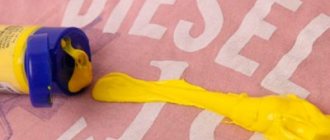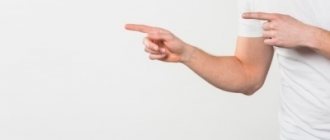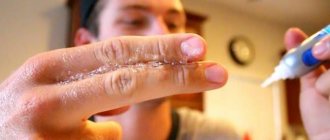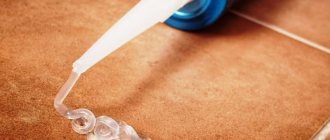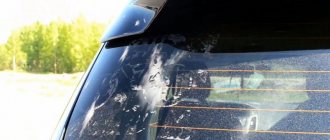Features of sneaker materials
Nowadays, shoes with white soles made of wear-resistant rubber or synthetic materials - filight, polyurethane, ethylene vinyl acetate, phylon have become very fashionable.
They give sneakers and sneakers strength and elasticity. The materials for the soles are highly resistant to aggressive environmental influences. Despite this, during wear they become covered with various stains, become yellowish or acquire an unpleasant shade of gray. Sometimes the sole has grooves around the perimeter, which complicates the situation with cleaning the shoes. To ensure that white sneakers last as long as possible, you need to regularly clean not only the upper, but also the sole. The material from which it is made is of great importance. A soft, damp cloth is ideal for cleaning the leather, while the rubber sole can be cleaned with a regular eraser or melamine sponge.
To prevent yellowish stains from appearing on the white sole, it is important to regularly wash off all contaminants.
What is harmful to artificial leather?
The natural material from which shoes, clothing, and furniture upholstery are made is durable and elastic, but is expensive, and animals are killed for its production. The basis for eco-leather is cotton fabric, onto which polyurethane is applied.
High humidity
Eco-leather does not allow water to pass inside. The machine is not suitable for washing products made of two-layer material; the dirt on them is not washed off with water. Strong humidity has a negative effect on fabric.
Heat
Eco-leather allows heat to pass through well, products made from it do not fade in the sun, but they overheat strongly; washing in hot soapy water is not recommended.
Cleaning with a steam generator
Synthetic fabric with a polyvinyl chloride coating is not inferior in technical characteristics to leather, looks similar to natural material, but if not properly cared for, it loses its attractiveness. You cannot clean products made from it with a steam generator.
Abrasives
If you wipe eco-leather with a hard brush or pumice stone, scratches, microcracks, and small cuts appear on the surface. The fabric is damaged when cleaning with abrasive materials and does not tolerate chlorine.
Daily care rules
Furniture upholstery and clothing made from light eco-leather remain attractive and do not wear out for a long time if the products are regularly and properly cared for:
- Remove dust with a damp cloth.
- Wipe off dirt with napkins made of calico, microfiber, or flannel.
- Treat with a water-repellent compound every 6 months.
- Polish to restore shine with creams intended for natural leather.
When cleaning stains, do not press on the surface of the car seat cover or upholstery. A sofa or chair made of two-layer material should be installed away from radiators, making sure that direct rays of the sun do not fall on things.
Skin of hands and face
Carrying out painting work without individual skin protection will certainly manifest itself in splashes of paint on the face and stains on the hands. You need to deal with them carefully, using washes that are gentle in composition. How to remove paint from the skin of your hands or face?
A time-tested product that gently removes oil paint from the skin. You just need to wipe off traces of paint on your face and eyebrows with a cotton swab generously dipped in vegetable oil. If your hands are dirty, you can wash them by pouring the oil directly into your palm, rubbing thoroughly and rinsing with warm water and soap.
Designed to eliminate color defects in eyebrows and hair, but can also be used to combat other types of coloring compounds. They remove water-based paint, acrylic paint and small drops of oil paint well. Use according to instructions.
A fairly strong solvent, which is not recommended for cleansing facial skin. The skin on your hands is less sensitive, and paint stains on them can be wiped off by blotting the contaminated areas with cotton wool soaked in acetone. If the paint comes off poorly, you need to take a short break and repeat the procedure after 30-40 minutes, otherwise skin irritation, even burns, cannot be avoided.
We wrote about how to remove hair dye in this article.
When painting windows or walls, oil-based or water-based paint can seep through gloves and get on your hands. If you move the brush carelessly, drops can get on your face and hair. After painting your head, a dark or red stripe may remain on the forehead or temples.
To wash marks from the skin, you need to pay attention to the composition of the material.
To remove oil-based paints and varnishes, solvents (white spirit, gasoline, turpentine) are used. These liquids dry out the skin, and in rare cases an allergic reaction may occur. It is safe to remove stains from skin using olive or sunflower oil.
Rub the dirt with a cotton pad soaked in oil until it disappears completely.
It's easy to wash off acrylic paint from the body before it dries. To do this, just wash your hands with soap and warm water. For dried stains, try soaking them in warm water for 15 minutes.
If soaking your hands doesn't help, use fine-grained pumice. Stains on the face can be washed by applying a cotton pad soaked in soapy water to them. The water-based emulsion is washed off the skin with ordinary laundry soap.
How to remove yellowness from white sneaker soles
Usually even the dirtiest shoes can be restored to their original appearance. To do this, just clean it well. You can try to do the same with old sneakers whose soles have acquired a yellowish tint. However, cleaning the yellow color is not always possible, even if you take your shoes to the dry cleaner. The result depends on how the spots appeared.
- If the sole has acquired a yellow tint due to ingrained dirt or dust, then it will not be difficult to fix it.
- But the sole can also turn yellow if you constantly dry your shoes on a radiator (or near it). Leaving your sneakers in bright sunlight for several days will have the same effect. The whiteness of such a sole can only be restored by painting it with white acrylic paint. The painting agent must not be water-based.
To make the dye stick more firmly, you can dry the sole with a hairdryer. The effect will be long lasting and will not disappoint your expectations.
Good acrylic will not wash off. It can be dried with a hot hairdryer to fix the dye.
If stains on the white sole appear from ingrained dirt, then they can be easily wiped off using household products.
Wash in washing machine
The simplest and least labor-intensive way to remove dirt from the soles of sneakers is to wash them in a machine. Algorithm of actions:
- remove the insoles and laces;
- wipe your shoes with dust and dirt;
- load it into the car.
You can purchase a special laundry bag.
The sneakers should be washed on the “delicate wash” program, do not wring out. Use a small amount of washing powder or gel (if the sneakers are plain white, it is acceptable to use a stain remover). Shoes should be dried naturally, away from heating devices.
We save clothes
Clothes are the first to get dirty. Do not rush to throw away “stained” things or send them to the dacha to serve as a robe. You can remove stains even from thin, delicate fabrics if you follow the following rules:
- Fresh paint comes off easier than dried paint. Don't hesitate to wash, no matter what kind of stain it is.
- The denser the material, the less likely it is to damage the fabric during cleaning.
- Do not use reagents (solvents or acids) without first testing and reading product labels.
Fresh oil paint can be removed using acetone (nail polish remover), lighter fluid, or turpentine. How to remove acrylic paint from ceramic tiles? Turn the product inside out and place three layers of paper napkins under the stain. Treat the stain with a cotton pad soaked in solvent, moving from the edges to the center.
When working with delicate fabrics, replace the solvent with warmed glycerin. Old dried stains can be wiped off with white spirit.
You can wash water-based paint before it dries with plain warm water and laundry soap. If the stain has dried, the material needs to be soaked. To do this, place a sponge soaked in water on the contaminated area for half an hour.
For best results, use Antipyatin soap or stain remover. Acrylic paint can be easily removed with isopropyl alcohol.
The task becomes more complicated if hair dye (especially with a dark pigment) gets on your clothes. If this happens before your eyes, immediately remove the item and place the stain under warm running water. If the dye has penetrated into the fibers of the fabric, use 3% hydrogen peroxide.
Apartment renovations, freshly painted benches on the street, childish pranks - all these are the reasons for the appearance of colorful stains on clothes. You shouldn’t rush to take a “stained” item to the dry cleaner - in most cases, you can clean clothes with improvised means. So, how do you remove paint from clothes?
Eliminates traces of gouache, watercolor, acrylic and water-based paint. You just need to soak things in warm water for 10-15 minutes, then hand wash them with laundry soap.
Refined gasoline, white spirit, acetone, kerosene. The only way to remove stains left by oil paint. To do this, apply a cotton pad soaked in solvent to the stain, after placing a clean cotton pad under it on the wrong side of the fabric. After 5-10 minutes, wipe the stain from the edges to the center. Finally, the stain is washed under running water and washed in the usual way.
Helps save natural woolen clothes. A cotton swab is moistened in warm vegetable oil and wiped the contaminated area in a circular motion. After that, wash on the “Wool” mode with any detergent.
- Refined gasoline white clay
The combination of two cleaning components allows you to successfully and without consequences remove paint from white clothes. To do this, gasoline and clay taken in equal proportions are mixed to obtain a slurry, which is then applied to the paint in a thick layer. After three hours, the dried composition is cleaned off with a clothes brush.
We suggest you familiarize yourself with how to clean silicone
Can I remove it myself?
You can remove paint stains from clothes if you do it correctly.
The complexity of the work is due to a number of factors, including:
The type of matter matters. Paint penetrates faster and deeper into fibrous fabrics than into a smooth surface. The task becomes more difficult if the stain was applied to delicate fabrics.
When can you handle it yourself, and when should you turn to professionals for help?
Before you begin processing, you need to pay attention to the following points:
How can you clean it at home?
The use of folk remedies is an ideal way to independently clean shoes from dirt and yellowness. For this use:
- toothpaste (powder);
- hydrogen peroxide;
- citric acid;
- a mixture of soda and vinegar with water;
- nail polish remover;
- eraser or melamine sponge.
Toothpaste
For this method, it is better to choose a composition with a whitening effect without color additives.
- Use a stiff bristle brush and toothpaste to clean the surface.
- Wait 20 minutes.
- Rinse shoes thoroughly in warm running water.
Hydrogen peroxide
Treat problem areas with hydrogen peroxide (3%). This solution will return the sole to its ideal white color and carefully remove any stains.
Hydrogen peroxide is an excellent tool for whitening the soles of sneakers.
Lemon acid
Citric acid or lemon pulp will help remove the yellowish tint and gray deposits.
- Rub the problem areas thoroughly with powder or pulp.
- Leave for fifteen minutes.
- Wash well with clean water.
There are three options for using baking soda and vinegar to remove stains from rubber.
- Wipe problem areas with a solution of vinegar and water in a ratio of 1:3.
- Prepare a paste of vinegar and soda in a ratio of 1.5:1, apply it with a sponge to the sole. When the mixture dries, wash it off with warm water.
- Thoroughly rub dirt with baking soda using a damp brush, removing dirt from all grooves on the rubber, and then rinse the shoes with water.
When using these products, excellent results are achieved, but they have a strong odor, which complicates the work. In addition, there is a risk of damage to the integrity of the sole. Therefore, before cleaning, it is necessary to carry out a quick test: apply the liquid to an inconspicuous small area. If no damage appears, you can use the product.
- Soak a cotton pad with acetone.
- Gently wipe the surface.
- Wash shoes thoroughly with clean water.
You need to use a white eraser that does not leave streaks on the surface when erasing.
- Use an eraser to process the corrugated sole, not missing a single indentation, thoroughly removing yellowness, dirt and black stripes.
- When finished, wipe the product with a clean soft cloth.
There is no need to use water with this cleaning method. For one pair of shoes, you need to take a fairly large eraser, and if the surface of the sole is uneven, you will also need small pieces to clean the thinnest grooves. The hard side of the eraser can damage the structure of the material and leave unwanted marks. For this reason, you only need to use its soft side.
Using a melamine sponge is much easier: wet the sponge, wring it out and wipe the shoes with it. It is softer than an eraser and more pleasant for the hands, but is still a harsher product. This does not guarantee perfect cleanliness if the yellowness is deeply ingrained into the sole, but the shoes will look much whiter.
Heavy stains, such as marks from paint, markers, pens, grease or shoe glue, can be removed using the following methods:
- a solution of soda and lemon juice;
- ammonia.
Cleaning procedure:
- Treat the problem area with a solution of baking soda and lemon juice. After this, wash your shoes thoroughly in clean warm water.
- Mix 250 ml of water with ammonia (1 teaspoon). Treat the stain with the solution and wait ten minutes. After this, wipe the shoes with a dry soft cloth.
It is recommended to wipe off dyes using the following available means:
- oil and alcohol;
- nail polish remover;
- baking soda with dishwashing liquid;
- scrub;
- vinegar;
- kefir;
- toothpaste.
These products are non-aggressive, unlike solvents, which are most often used to remove dyes from clothes.
It is recommended to first try to scrub off any types of substances with soap and water. Many substances are washed off well with a soap solution. After treating the skin with it, you can move on to mineral oil. It is considered an excellent cleanser.
Mineral oils are good for removing water-based and oil-based stains. They also remove latex paint quite well.
It is recommended to use sunflower or linseed oil. Olive is also suitable. You can use Johnson's baby oil.
To remove a dye stain, you must:
Generously moisten the area where there is a trace of paint with oil.- Rub in the mixture thoroughly.
- Wait until the oil is well absorbed. 3 minutes is enough.
- Rub the stain vigorously with a stiff washcloth.
- Additionally, treat any remaining paint marks with an alcohol solution.
- Wash your hands with soap.
The alcohol solution greatly dries out the skin. Due to its irritating effect, they may begin to peel off. To avoid this, after treating the skin with alcohol, rub a moisturizer into it.
This product is a good solvent. A component of such liquids is acetone. It is often used as a solvent.
It is necessary to soak a cotton pad in nail polish remover and carefully wipe the paint stain on the skin with it. You can repeat the procedure several more times. After treatment, wash the skin thoroughly with soap.
Nail polish remover should not be used to remove paint stains on the face. Acetone can cause severe eye irritation. The product is best used for washing dyes from hands.
Baking soda is a good cleaning agent. Dishwashing liquids contain surfactants and glycerin, which have good cleaning properties. It is recommended to use the products together.
To do this you need:
- Mix a large spoonful of liquid with a small spoonful of baking soda.
- Mix the ingredients.
- Thoroughly rub the resulting soap foam into the stain.
- Wash off the mixture from the skin with warm water.
To enhance the effect of the combination of these products, it is recommended to add a small spoon of lemon juice to them.
The components of body scrubs are abrasive particles. They are good at scrubbing away impurities on the skin. Abrasive particles also penetrate well into contaminants, which is why scrubs can be used to remove dyes from the skin.
It is necessary to apply the scrub to the dirt and thoroughly rub it into the skin. Then the product is washed off with warm water.
This product contains acetic acid. It acts as a good solvent. It is enough to soak a cotton pad in vinegar and wipe the paint mark with it. Then you need to wash the treated area with warm water and soap.
Vinegar should not be applied to the face; the acid can cause burns. It is especially dangerous for mucous membranes and eyes.
This product includes many abrasive particles. Compounds such as silicon and titanium dioxides and aluminosilicate actively remove contaminants.
Thanks to this composition, toothpaste can be used to remove paint from the skin. Whitening pastes that contain silicon hydroxide cope especially well with this.
It is recommended to use the product in combination with soda according to the following scheme:
- Apply a little paste to the stain. Distribute it evenly.
- Apply baking soda to the area treated with the paste. Wait 5 minutes.
- Rub the mixture into the skin with quick movements.
- Rinse the treated area with warm water.
It will be necessary to repeat the procedure if the stain still remains on the skin.
Due to the presence of acetic acid bacteria, alcohol and carbon dioxide in it, this fermented milk drink can be used to remove dyes from the skin. Kefir is especially good for scrubbing off hair dye stains.
It is necessary to moisten a cotton pad in any kefir and rub the drink into the area of contamination. You need to wait 10 minutes for the kefir to be well absorbed. Then the mass is washed off with warm water.
What do we need
The task was set: to clean nubuck weekend shoes at home. You will need: a can of foam or spray, a brush, an eraser and a little ingenuity. The products are applied alternately, depending on the degree of contamination and the expected effect. It is also possible to use improvised methods, which will be discussed separately.
Impregnation in the form of an aerosol
The initial stage involves treating nubuck with aerosol impregnation. Sprayed from a can, dries quickly, leaving a protective hydrophobic layer on the surface. Of the well-known and eminent ones, Salamander is used, there are also simpler options - Shtrikh, Centro, Erdal.
Cleanser (foam)
A relatively simple way to restore the exterior of nubuck boots. The consistency is similar to shaving foam. It is applied to the surface to be treated, then the active reagent binds dirt particles, “knocking” them out of the pile. All you have to do is wait for the foam to dry, and then clean the nubuck with a special hard brush.
Spray paint for nubuck shoes
Among the manufacturers are the famous Salamander, Centro, Erdal
It is important not to confuse the color of the shoes and the color of the aerosol, so as not to hopelessly ruin the shoes. There are no universal (colorless) dyes; specific instructions and recommendations are indicated on the container with the composition
Eraser
A special rubber band will help remove dirt from shoes and restore lint. Work with an eraser on a dry surface, systematically wiping away foreign inclusions.
Sometimes this helps to avoid the use of radical cleaning agents when the shoes are not too dirty or worn.
Special brush
Let's make a reservation right away: we are not talking about toothbrushes, old clothes or anything else like that. You will need special products - with rubber or metal bristles. By the nature of its effect, the brush resembles the abrasive that initially creates the structure of nubuck: it also restores the pile and removes stubborn dirt.
Shoe deodorant
A special product allows you to get rid of unpleasant odors and clean the inside surface of your shoes. The appearance of a specific amber is associated with various reasons: the habit of wearing boots, shoes on bare feet, excessive sweating, and so on. The deodorant eliminates odors and restores shoes to their original condition.
Clean the soles of sneakers using household chemicals
Household chemicals make it much easier to achieve your goal - to erase all dirt and remove yellowness. Whatever chemical you choose, shoes must first be prepared for cleaning:
- remove the top layer of dried dirt using a damp cloth;
- mechanically clean the sole from large pieces of debris;
- wash in warm soapy water.
- Grate the soap and dilute it with water to form a paste-like mass.
- Using a brush, apply the paste to the sole and rub the stains.
- Let stand for about an hour and rinse well in running water.
Dishwashing liquid is used in the same way.
Laundry soap makes a good product for caring for white soles.
Washing powder does a good job of removing yellowness from soles. To do this, use a mixture of it with vinegar and hydrogen peroxide.
- Mix the powder with hydrogen peroxide and vinegar in equal proportions.
- Apply the resulting mixture with a brush to the surface of the sole.
- Wait 15 minutes.
- Wash with plenty of clean water.
We suggest you familiarize yourself with How to clean light leather jackets
Oxygen-containing laundry detergents contain sodium percarbonate and other similar chemical compounds that easily break down and release oxygen during use. Under its influence, contaminants are oxidized and purified. In this case, no damage is caused to things.
- Soak the soles of sneakers (not higher) in this product for two hours.
- Wash thoroughly with plain water.
Stain remover
You should use a product for white fabrics so as not to disturb the structure of the sole material.
- Rub the sole with stain remover using a stiff bristle brush.
- Leave the shoes for 3-4 hours.
- Rinse the product thoroughly with warm water.
Yellowness from the sole is removed with a stain remover for white fabrics
Bleach will help make the condition of the white sole almost perfect. But it is advisable to use oxygen-containing products. They cope with almost all types of stains: grass stains, iodine and brilliant green, blood.
The reaction of materials to chemical cleaners may vary. To make sure that the chosen product is safe for the sole, you need to apply it to a small, inconspicuous area of the surface and wait a couple of hours. If no cracks or holes form, then you can safely begin work.
- Prepare a solution of bleach and water in a 1:2 ratio in a wide basin.
- Place the shoes in the basin so that the solution covers the sole without touching the top.
- Leave the sneakers for an hour and then check to see if the shoes have bleached.
- If the result is achieved, thoroughly rinse the solution from the sole; if not, put the shoes back in the basin for a while.
- Relief depressions, microcracks and curves can be additionally cleaned with a brush, removing remaining stains of dirt and yellowness.
For practically new shoes, you can use bleaching laundry detergent.
- Mix the powder with water to form a paste.
- Apply the resulting mixture to the sole and wait half an hour.
- Treat the product with a stiff bristle brush, removing dirt.
- Rinse everything off with water and wipe the shoes with a clean soft cloth.
Why do leather shoes stain your feet?
Why shoes
starting to color?
... Moisture getting on the insert causes the suede to fade and begin to stain. BUT: if leather shoes stain your feet
(the entire foot), then they are actually defective and made from low quality materials.
Interesting materials:
How to move from mass to volume? How to switch from aluminum wires to copper? How to switch from a cast iron pipe to a plastic one? How to switch a motor from star to delta? How to switch to a boiler? How to repaint a chipboard kitchen? How to repaint chipboard furniture? How to repaint the ceiling? How is alternating current? How to re-register a dacha from father to son?
How to remove oil paint?
Dealing with marks left by oil-based paint is not easy. The best results come from trying to remove small drops of still fresh paint - in this case it is enough to simply remove it with a damp cloth. Large areas of recent stains are wiped off with a cotton swab or cloth soaked in vegetable oil.
Various shapes and sizes, brushes are used for priming and painting walls, ceilings, baseboards, doors and wooden window frames. Used in work, but left for a while in the open air, they may become unusable. The paint sets quickly, the bristles of the brush stick together and in the future it becomes inconvenient, if not completely impossible, to work with such a tool. Are there ways to preserve brushes and clean them of paint after use? And how to clean the brush from paint after repair?
- Washing conditioner
Helps remove fresh paint from the bristles. To do this, remove its remains by wiping the brush on paper. The conditioner is mixed with water in equal proportions and the brush is rinsed in the resulting solution until the paint begins to gradually separate from the bristles. Rinse the brush under running warm water. Repeat the procedure until the desired degree of instrument cleaning is achieved.
You can use it to clean the brush from paint that has already dried. The brushes are soaked in the essence for 60-80 minutes, boiled in a fresh portion of vinegar (10-15 minutes). Then comb out thoroughly with a steel brush or a fine-toothed comb. Repeat the procedure until the paint is completely removed, rinse with warm water and dry.
- Solvents (white spirit, alcohol, refined gasoline)
Copes with all types of coloring compounds. To obtain a good result, brushes are soaked in a container with any solvent for a period of half an hour to 1 hour, rinsed in a fresh portion of the solvent and washed thoroughly with water.
- Specialized solvents (“Universal Cleaner”)
They can be found in hardware stores and amateur radio departments. It contains alcohol and gasoline, so it removes both acrylic and oil paints from brushes equally well.
How to clean makeup brushes
1. Baby shampoo
For many years I have been washing my brushes with baby shampoo. During all this time, they did not lose their shape, but, on the contrary, retained it.
How to wash makeup brushes with shampoo
First, squeeze a drop of baby shampoo onto a cotton swab. Carefully dip the brush into the detergent. “Twist and twirl” on the palm until the bristles of the brush are clean. Rinse with water.
Bottom line: this method is suitable for brushes that only you use. If you work as a makeup artist, then you definitely need to disinfect your brushes! And the next option is just for you.
2. Special products for cleaning brushes (Makeup Brush Cleaners)
Similar liquids can be found in every brand. This applies not only to professional, but also luxury brands, for example:
- Bobbi Brown Conditioning Brush
- Clinique Makeup Brush Cleanser
- Estee Lauder Makeup Brush Cleaner
- Mac Cosmetics Makeup Brush Cleanser - I use it to wash my “working” brushes (read the review here).
How to wash your brushes with a special brush cleaner
I talked about this in detail in the article “How to wash brushes using a special product”
Bottom line: the difference between these products is that they contain alcohol, which is necessary for disinfecting brushes!
If you are afraid that alcohol will have a bad effect on the pile, then this is not so. A certain amount of alcohol has long been calculated in such products and believe me, they are not intended to destroy brushes, but only to disinfect them.
3. Tea tree oil
It has been noticed that tea tree oil has antibacterial properties, although not as strong as previous products.
How to Clean Your Brushes with Tea Tree Oil
- Add 3-4 drops of tea tree oil to a container of warm water.
- Lower the brush and rinse.
- To make sure your brushes are clean, you can add one teaspoon of baby shampoo.
Bottom line: I have never tried this cleaning method, but I have heard about it as the most positive method.
4. Wipes or makeup remover as a way to clean brushes (Makeup Remover Wipes)
This method is convenient when traveling when you don’t have any oil, special product, or baby shampoo on hand! I am sure that not a single girl will forget to take makeup remover on a trip. This is exactly what will help your brushes out.
How to Clean Your Brushes Using Makeup Remover Wipes
- Soak a cotton swab in makeup remover
- Run the brush over it a couple of times until it's clean.
- The same can be done with napkins - using circular movements of the brush until completely clean.
5. Laundry soap
The only product that completely removes creamy textures from your brushes! This applies to watercolor paints, waterproof cream eyeshadows and foundation.
How to clean brushes with laundry soap
- Swipe the brush over the soap a couple of times
- Using circular movements on the palm, cleanse.
- Rinse with water.
Bottom line: I am completely calm about the condition of the brushes after this method of cleaning, since when working with cream textures you are only dealing with synthetic, not natural bristles. This is the only soap I can use to wash my brushes after creative makeup.
How to dry makeup brushes
- After you have washed your brushes, do not place them immediately in a glass, otherwise water will get into the fastening area and dilute the glue! Result: the handle fell off.
- Place them on a previously laid out napkin on the table. I use kitchen paper towels.
- Wash your brushes at least once a week. If you have rashes and other skin problems, then try to wash them much more often, at least every other day.
Gossip
- They say that brushes that have lost their shape can be brought back to life by keeping them in water at 90°C. about 3 minutes.
- They also say that you can disinfect brushes with chlorhexidine, as one of the cheapest options.
I haven’t tested these options because I don’t want to risk the brushes that I love very much and treat them with care.
Conclusion: It’s up to you how long your makeup brushes will last you. Choose cleaning products depending on the task you are facing. Dry them properly and keep them clean.
Is it worth trying to wash stains on the soles of sneakers in a washing machine?
The easiest way to clean your favorite shoes is by washing them in the machine. This method does not always give the expected result, and sometimes it can be completely useless and unsafe for shoes. After machine washing, sneakers tear and lose shape much faster.
In addition, there is a danger that the snow-white sole will acquire a yellowish tint and begin to peel off. However, if you still decide to go with a washing machine, then you need to follow a few simple rules.
- Before loading sneakers or sneakers into the washing machine, you must remove the insoles, laces and other removable parts.
- It is necessary to remove adhering dirt with a brush and soapy water and dry. The sole tread should be especially carefully cleaned of small stones and sand, as their entry into the machine can damage the drum, pipe and filter.
- It is strictly forbidden to soak shoes before washing. When dried, it will lose its shape.
- It is better to set the delicate mode with minimal speed and additional rinsing. The spinning and drying must be turned off, otherwise the sneakers will get wet and come apart.
- The optimal water temperature is 40 °C.
- Shoes should be washed in a special bag, and some other things should be placed in the drum to soften the shock during rotation.
It is better to dry sneakers after machine washing in the usual way at room temperature, stuffing them with crumpled newspapers. The paper will prevent deformation during drying and absorb excess moisture. You can also dry your shoes using special dryers.
When the shoes are completely dry, apply a water-repellent agent to them. It is strictly forbidden to dry sneakers and sneakers on a heating radiator or with a hair dryer. This can lead to deformation, the sole will turn yellow and it will be more difficult to bleach it.
We tidy up suede shoes
Shoe paint is made on a nitro base and can be cleaned with acetone or simple nail polish remover. It is advisable to combat contamination with the help of special solvents 646 and 647. The listed products are applied to a clean cloth and thoroughly wipe the area of the surface damaged by paint.
Baking soda and kitchen cleaners can also remove shoe paint from floors (except linoleum). For this cleaning method, soda is mixed with water to form a slurry, then applied to paint marks and left for 5-10 minutes. Then rub with a damp cloth and wipe dry.
How to keep your sneakers white and protect them
To maintain the results of cleaning white soles for as long as possible, just follow some simple recommendations.
- Store sneakers and sneakers away from direct sunlight.
- After returning from a walk, wipe your shoes from dirt and dust with a damp soft cloth or sponge, let them dry, and then treat them with a special colorless cream, which will serve as a kind of protection for the soles.
- The soles should be cleaned at least as often as the uppers of the shoes. This will prevent cracking and the formation of hopeless stains.
- To prevent the formation of cracks, you can treat the sole with a special silicone gel, which has a water-repellent effect.
- Protective water-repellent impregnations should be applied regularly and only to clean and dry shoes.
- And, of course, you need to wear shoes carefully, avoiding dirt and puddles.
These simple tips will help keep your favorite pair of sneakers clean and looking great for a long time.
Wearing sneakers with white soles and taking proper care of them is not that difficult. If you take care of the cleanliness of your favorite pair in time, it will last a long time and look like new.
Use of special means
To care for white sneakers, you can buy ready-made products. The attached instructions describe how to use them correctly.
Foaming detergent
This is shoe shampoo. Apply the product to shoes using a sponge and rub the surface until foam forms. You can use a brush. After treatment, the foam is washed off with water or wiped with a damp cloth.
Conditioner for leather shoes
The conditioner softens the leather and protects it from cracks and drying out. Clean and dry shoes should be treated with this product. Use a soft cloth to apply to the surface. If there are a lot of scratches on the surface, you can buy a conditioner that is a lighter tone. The product is first applied to the product, allowed to dry, and then polished.
Stain removers and bleaches
To remove stains or dirt, the stain remover is dissolved in water and applied to the sneakers. You can put the shoes in water with bleach for several hours, and then go over the surface with a brush.
Plastic, laminate, linoleum, tile
Quite durable if properly cared for, linoleum and plastic can suffer serious damage if paint gets on them. If the stains were left behind by water-based compositions, there is no need to worry; they are easily washed off with water, leaving no traces. Oil paint stains must be removed very carefully, using mechanical or chemical cleaning methods. So, how to remove paint from linoleum?
If drops of paint have not yet dried, just remove them with a clean rag or paper. Dried marks must first be soaked by placing a cloth soaked in vegetable oil on the stain. After 15-20 minutes, the paint layer is slightly lifted with a construction scraper, spatula or simply a knife and carefully removed from the surface to be cleaned.
We suggest you familiarize yourself with How to remove old paint from walls: how to quickly remove acrylic, oil and water-based paint from concrete, wood and other coatings?
To remove paint from plastic, household solvents will come to the rescue - alcohol, white spirit, acetone and specialized compounds - solvent 646, HAMMERITE solvent and cleaner, KUDO old paint remover and others. Use according to the instructions on the package.
Acrylic paint is not easy to wipe off a surface once it has dried. Fresh stains can be treated with water and laundry soap (or Antipyatin soap). The only way to get rid of a stubborn stain is to buy a special remover.
When purchasing, consult with the seller, telling him the brand of acrylic paint you are using.
The cleaner has a pungent odor; open the windows in the room before use. How or with what to remove old paint from bathroom walls? Do not be afraid to treat plastic surfaces; the substance does not react chemically.
Do not use solvent on colored upholstery.
Water without added detergents will help clean hands, hair, carpeting, plastic and wood.
Oil-based paint is washed off with special solvents or vegetable oil. Solvents are safe to use on linoleum, some types of fabrics and tiles. Tile, like glass, is not afraid of exposure to even the harshest chemicals.
To remove paint and varnish from a plastic window sill, use vegetable oil or warm glycerin. The solvent will leave a matte stain in place of the dye.
Wash away stains from the spray can
Aerosol paint today is widely used by both street graffiti artists and serves as a worthy alternative to conventional materials for painting work. How to remove paint from a can? Most paint cans contain varnish, so it is difficult to wash them with plain soap and water. To remove traces of aerosol paint, you need to use chemical solvents.
- Alcohol, acetone, refined gasoline, white spirit. To obtain a good effect, apply a clean cloth soaked in solvent to the problem area of the surface and leave for 5-10 minutes. Then remove the paint with a dry cloth or paper, rinse the surface well with water and wipe dry;
- Specialized solvents 647 and 650. You can purchase them at a hardware store. The operating principle is similar to the previously described solvents;
- Professional anti-graffiti products. They are used mainly in car washes to remove traces of aerosol paint from car bodies, but can also be used to clean other surfaces, even wood. These can be “GraffiGuard” (), “Antigraffiti” (GRASS), Anti-Graffiti (“Clean”) and many others - the choice is quite wide.
How to remove tar from a car
We take a dry rag and soak it in gasoline, then rub it over the stains from tar or bitumen. We wait about 3 minutes and wash off the stains from the body with the same rag. The paintwork of modern cars is quite durable, so don’t be afraid to use gasoline. The main thing is that the coating is not damaged before and during such treatment. Therefore, do not allow sand or other abrasive material to get on the cloth.
If your car is not new or you are still afraid to use gasoline, then modern chemical manufacturers offer you a wide range of special products taking into account all the features of car coatings. Sales consultants at any industrial chemicals store will promptly select the necessary product for you.
How to remove an old dried stain?
The basis for success in the fight against old traces of paint on any surface is pre-soaking the stains. As they soften, they are removed more easily and without leaving any traces. Soaking is carried out in several ways:
- Turpentine. Apply liberally to the paint and hold until it “wrinkles” and softens. Then treat the surface with a concentrated solution of baking soda and rinse with clean water.
- Margarine/butter. A small piece of the product is left on the paint for a while, after which it is rubbed with a gauze swab soaked in turpentine, gasoline or kerosene, and the solvents are washed off with water.
How to wash window glass?
Drops of paint on window glass are a nuisance that often accompanies home renovation work. Fortunately, dealing with it is not particularly difficult.
- Silicate office glue. Allows you to get rid of small splashes of paint. They are generously smeared with glue and left for a while. As the glue dries, it will begin to shrink and pull paint particles behind it, leaving the glass clean.
- Ammonia. Prepare a solution from 1 tbsp. ammonia and 1 liter of water. Use a sponge soaked in the solution to wipe the glass until the dirt is completely removed. Rinse the glass with clean cool water and wipe dry with a cotton cloth.
How to wash black marks and stripes on velor or nubuck
Shoes made of velor or nubuck look great, but require careful cleaning after every trip outside. If we talk about assistants in removing dirt, then the best option is a special brush (these are sold in shoe stores), which must be used to treat the pair daily.
Light-colored nubuck shoes require daily cleaning
To remove traces of dirt and black streaks from the surface, use the means at hand.
Methods for removing dirt from nubuck and velor shoes - table
| Means | How to cook | Mode of application |
| Ammonia | Dilute with water in equal proportions |
|
| Vinegar solution | 1 tbsp. l. 9% vinegar per 0.5 liter of water |
|
| Ethanol | Dilute with water in equal proportions |
|
Once every 1–2 weeks you need to treat velor shoes with a soap solution:
- dilute 1-2 tbsp. l. liquid soap in ½ liter of warm water;
- soak a soft toothbrush in the solution and scrub the surface;
- Wipe your shoes with a soft cloth soaked in cool water.
To remove greasy marks from velor or nubuck, apply a piece of stale bread to the problem area, blot lightly (or just press for 2-3 minutes), and then comb the pile.
How to clean up wet nubuck boots
Bad weather causes two problems with velor shoes: pairs become wet and dirty. The plan of salvation involves action in both directions. Let the shoes dry first. Then use steam to “open” the pile and brush it with a soft toothbrush. You can steam it over a kettle or using an iron. Just keep in mind that you should not touch the hot sole of the device to your shoes.
Washing a dirty car
Paint that gets on the car body causes serious concern and inconvenience to car owners. After all, it is very difficult to remove paint from a car, even small traces of it, without damaging the paintwork of the body. But if you wish, you can try to get rid of unnecessary “artwork” on your car, acting thoughtfully and carefully.
Gentle solvents such as gasoline and white spirit are suitable for removing paint. Some car owners recommend non-standard solutions - treatment with brake fluid or alkaline compounds (sodium hydroxide). When using them, it is important to be extremely careful - treat the stain directly without touching clean areas of the surface, do not leave solvents on the stains for a long time and clean off the paint with smooth cross-shaped movements, without excessive zeal. If there is a subtle change in the color or gloss of the surface, treatment should be stopped immediately and the solvent wiped dry.
Clay for car cleaning (“Willson”, “SONAX”, “ZM”, “Detailing clay”) is a new product on the market of cleaning products for cars. Designed to remove bitumen stains, but also successfully copes with minor paint stains. Purchased from auto stores and used according to instructions.
Cleaning any surface from paint stains is a labor-intensive and complex task that requires a competent approach. Only by studying and choosing the right methods for removing contaminants can you achieve success and return any things to their former appearance - from your own skin to clothes and cars.
Chemical method
To get rid of stains chemically, cleaning products containing active chemicals are used. The most commonly used products are acetone, paint thinner, and other products that contain alcohol.
Important! However, these agents should be used with caution. If a small stain occurs, you need to pour a small dose of the product onto a sponge and rub it over the surface with smooth movements.
Removal nuances depending on the type of dye
Hair dye is best wiped off the skin with alcohol-containing solutions. Special lotions and facial tonics are suitable for this.
An alternative could be vodka. You can use medical alcohol, but not too concentrated. It must be diluted with water.
Hair dyes are also easily removed from the skin:
- lemon juice;
- olive oil;
- vinegar;
- hydrogen peroxide.
The last two products should not be applied to the face. It is better to use peroxide to remove paint from your hands or feet. It is enough to moisten a cotton swab in it and wipe the dirt with it.
There are special removers. They are designed to remove hair dye marks from the skin. These are products under the brands “Estelle”, “Kapous”, “Wella”, “Galacticos Professional”.
Other types of paints have the following removal nuances:
- Oil paint is best wiped off with strong solvents. White spirit and turpentine are more suitable. You can use gasoline or acetone to cleanse the skin on your hands and feet. Such solvents can provoke allergic reactions. Therefore, they cannot be applied to the face. You can wipe off fresh oil paint from your face with olive oil.
- Fresh acrylic paint is quite easily washed off the skin with warm soapy water. Dried paint is pre-soaked with warm water for 20 minutes. Then it should be scrubbed with pumice. It is better to use its fine-grained version.
- Water-based paint is easily washed off from the skin with a solution based on laundry soap. Ink should be scrubbed with scrubs and hydrogen peroxide. For cleaning, it is recommended to use a pumice stone or a toothbrush.
Recommendations and prohibitions
To effectively wipe off any type of dye from the skin, the following must be considered:
you need to try to remove the mark as quickly as possible before the dye dries;- Do not etch paint stains on your face with solvents;
- it is necessary to wipe off dried traces of oil paint on hands and feet with solvents;
- before removing dried paint from the skin, you must first soften it with warm water for 10-20 minutes;
- It is recommended to wipe off any fresh paint with warm soapy water;
- You should use pumice stone and a toothbrush when scrubbing away dyes.
After any treatment of the skin with various means, it is necessary to wash it thoroughly with warm water and soap, and then use a moisturizer. It will soften the skin and prevent irritation from occurring on it.
When time doesn't heal
The higher quality the hair dye, the more difficult it is to remove stains from it on fabrics and other materials.
This is exactly how you can characterize the situation with hair dye stains on textiles, hard surfaces or paper: even from light dye, the mark will not disappear by itself. Moreover, over time, the coloring pigments will be so absorbed that it will be very difficult to get rid of them, and if we are talking about dark shades of the coloring agent, then it will be completely impossible . We also note the fact that fashionable beauties try to choose the most durable paint, and this significantly reduces the chances of success in the operation to remove contamination. From the above it follows that simple washing by hand or in a machine is not enough. We'll have to look for something more effective. To do this, we will group stain removal methods according to the type of impact on contamination.






